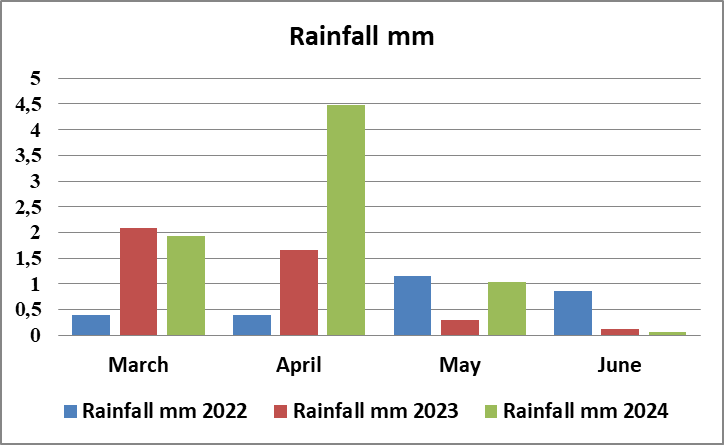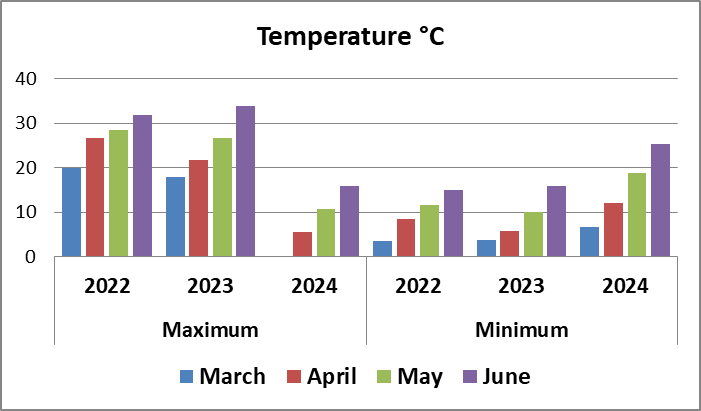Влияние различных концентраций NPK-удобрений и гиббереллина на рост и урожайность яровой пшеницы в условиях выращивания в Каписе, Афганистан
Влияние различных концентраций NPK-удобрений и гиббереллина на рост и урожайность яровой пшеницы в условиях выращивания в Каписе, Афганистан
Аннотация
Эксперименты проводились на экспериментальной ферме сельскохозяйственного факультета Университета Альберони, Каписа, Афганистан, с целью изучения влияния различных уровней внесения азотных, фосфорных и калийных удобрений (NPK) и доз гиббереллина (G) на рост и урожайность яровой пшеницы в марте-июне 2022-2024 годов. Эксперимент был проведен по рандомизированной схеме полного цикла с 3 повторениями и 12 обработками: T1 (контроль), T2 (N0P0K0 + 100 мг/л), T3 (N0P0K0 + 200 мг/л), T4 (120-60-30 кг/га NPK), T5 (120-60-30 кг/га NPK + 100 мг/л), T6 (120-60-30 кг/га NPK + 200 частей на миллион Г), T7 (160-90-60 кг/га NPK), T8 (160-90-60 кг/га NPK + 100 частей на миллион Г), T9 (160-90-60 кг/га NPK + 200 частей на миллион Г), T10 (200-120-90 кг/га NPK), T11 (200-120-90 кг/га NPK + 100 частей на миллион г) и T12 (200-120-90 кг/га NPK + 200 частей на миллион г). Результаты показали, что внесение различных доз удобрений NPK и G, за некоторыми исключениями, значительно увеличило рост и урожайность яровой пшеницы. Максимальная высота растений (106,3 см) была зафиксирована при внесении 200-120-90 кг/га NPK + 200 мг/млн. г, в то время как наибольшее количество сухого вещества на растение (5,8 г), масса 1000 зерен (47,1 г), количество зерен в колосе (48,7), урожайность зерна (4,51 т/га) и урожайность соломы (8,53 т/га) были зафиксированы при внесении 160-90-60 кг/га NPK + 200 ppm G.
1. Introduction
Wheat (Triticum aestivum L.) is a staple food crop for the people of Afghanistan , . In Afghanistan, this crop was considered a key factor in raising the level of farmers' economy, ensuring food security, as well as creating jobs for people, and consequently raising the level of the national economy (2, 3). Due to its wide genetic adaptability, wheat is cultivated in various climates throughout Afghanistan, both in spring and winter seasons , . Wheat occupies a larger area under grown, as compared to other crops grown in the country, accounting about 32 percent of the country's total cultivated area in 2024. This crop is usually grown in irrigated and rainfed forms and grown in all regions of the country. The wheat-grown season typically starts in October and continues until April, depending on the weather conditions of each region , . Drought, locusts, floods, diseases of rust and black smut, low seed quality, inadequate nutrient management, improper agricultural operations, low quality of accessible fertilizers in the market and less knowledge of farmer about the amount and their application of fertilizers are major factors that damage wheat and often reduce its yield , , .
In 2024, the total area under wheat cultivation in Afghanistan reached 2.12 million hectares, representing an increase of approximately 4.7% compared to the previous year. On other hand, the total wheat production was 4.83 million metric tons, which has an increase of about 10 percent compared to the previous year. While the country's need for wheat in 2024 was about 6.82 million metric tons, which, considering the domestic production of wheat, has resulted in a shortage of 2 million metric tons of wheat nationwide, which must be imported from abroad to meet the country's need. In 2024, the average wheat yield production per hectare in irrigated wheat was about 2.98 t/ha and rainfed wheat was 0.96 t/ha nationwide . Common chemical fertilizers in wheat fields of Afghanistan are nitrogen fertilizer in form of urea and phosphorus fertilizer in form of diammonium phosphate, which are used in different doses , . The application of all mineral fertilizers especially (NPK) for spring wheat determines the quantity and quality of the grain yield. The combined application of nitrogen, phosphorus and potassium fertilizers plays a significant role in wheat yield production . Plant growth regulators play an essential role in flowering, seed filling, seed maturation, and physiochemical variations during storage , . Gibberellin an important plant growth regulator, which stimulates different plant physiological processes, that includes seed germination, flowering, cell division and maturity, root development, etc. Gibberellin also increases resistance of plants to improper environmental factors such as salt, chilling, drought and micro nutrients stress , .
2. Materials and methods
The experiments were led at the experimental farm of agriculture faculty, Alberoni University, Kapisa, Afghanistan, which located in the north of the central region of Afghanistan, with warm summers and moderate climates in spring and autumn. It is about 1,500 meters above sea level, annual rainfall is estimated at about 400 mm, and summer temperatures vary from 25 to 40 °C. Data pertaining to rainfall and temperature that recorded during the experimental period depicted in Fig 1, Fig 2. The soil of the experimental field had sandy loam texture and was relatively alkaline in reaction (pH = 8.10). The soil have organic matter (humus) content (1.9 %), nitrogen content (0.11%), phosphorus content (14.0 mg/kg), potassium content (95.5 g/kg) and medium in water holding capacity (34.99 %). Data regarding soil properties of experimental field are presented in Table 1. The experiment was set out on randomized complete block design with 3 replications and 12 treatment: T1 (Control), T2 (N0P0K0 + 100 ppm G), T3 (N0P0K0 + 200 ppm G), T4 (120-60-30 kg/ha NPK), T5 (120-60-30 kg/ha NPK + 100 ppm G), T6 (120-60-30 kg/ha NPK + 200 ppm G), T7 (160-90-60 kg/ha NPK), T8 (160-90-60 kg/ha NPK + 100 ppm G), T9 (160-90-60 kg/ha NPK + 200 ppm G), T10 (200-120-90 kg/ha NPK), T11 (200-120-90 kg/ha NPK + 100 ppm G) and T12 (200-120-90 kg/ha NPK + 200 ppm G). Nitrogen, Phosphorus, and Potassium (NPK) fertilizers and Gibberellin (G) were applied according to the respective treatments before sowing and at various growth stages. The wheat variety used in this study was Kabul 013, a spring wheat variety commonly grown in Afghanistan. The plot size was 10 m², and wheat seeds were sown during the first week of March and harvested in the last week of June over three consecutive years (2022-2024). The seed rate was 125 kg/ha. Before sowing, the spring wheat seeds were treated with Vitavax to protect the plants against fungal diseases. Data analysis was performed using OPSTAT software.

Figure 1 - Meteorological data during experiments in Al-beruni University, Kapisa, Afghanistan in 2022–2024

Figure 2 - Meteorological data during experiments in Al-beruni University, Kapisa, Afghanistan in 2022–2024
Table 1 - Physical and chemical characteristics of Soil of the experimental field
Soil properties | Value |
A. Physical | - |
Sand | 44.11 % |
Silt | 10.29 % |
Clay | 45.58 % |
Soil texture class | Sandy loam |
B. Chemical | - |
pH | 8.10 |
Organic matter (humus) (%) | 1.9 |
Nitrogen (%) | 0.11 |
Phosphorus mg/kg | 14.0 |
Potassium mg /kg | 95.5 |
Water holding capacity (%) | 34.99 |
3. Results and discussion
Data pertaining to plant height as influenced by different levels of NPK and G are presented in Table 2. Plant height of spring wheat show significant improvement due to different levels of NPK and G. Application of NPK and G influenced plant height significantly compared to control treatment. Maximum plant height (106.3 cm) was recorded by using 200-120-90 kg/ha NPK + 200 ppm G, but it was statistically identical to 160-90-60 kg/ha NPK + 200 ppm G and 200-120-90 kg/ha NPK + 100 ppm G. The same results were found by Belopukhov et al.; (2024) ; Ramnath and Verma (2024) ; Malghani et al.; (2010) , that application of NPK and G significantly increased plant height of spring wheat.
Data regarding dry matter of spring wheat as influenced by different doses of NPK and gibberellin have been set out in Table 2. Dry matter/plant of spring wheat was improved favorably due to application of different amount of NPK and gibberellin. Use of NPK and gibberellin influenced dry matter/plant significantly over control and other treatments. However, the maximum dry matter/plant (5.8 g) was noted by using of 160-90-60 kg/ha NPK + 200 ppm G and 200-120-90 kg/ha NPK + 200 ppm G. Similar result was noted by Islam et al.; (2014) ; Qing et al.; (2006) ; Wang et al.; (2023) ; Duan et al.; (2014) ; Manzoor et al.; (2019) .
Table 2 - Effect NPK fertilizer and gibberellin on plant height and dry matter of spring wheat
Treatment | Plant height, cm | Dry matter/plant, g |
Average 2022-2024 | Average 2022-2024 | |
A1 | 76.6 | 3.6 |
A2 | 82.1 | 3.8 |
A3 | 86.0 | 4.1 |
A4 | 90.2 | 4.5 |
A5 | 93.0 | 4.6 |
A6 | 96.0 | 4.7 |
A7 | 98.5 | 5.2 |
A8 | 102.4 | 5.4 |
A9 | 105.7 | 5.8 |
A10 | 103.2 | 5.3 |
A11 | 105.5 | 5.4 |
A12 | 106.3 | 5.8 |
SEm± | 0.34 | 0.013 |
CD (P=0.05) | 1.00 | 0.039 |
Data on 1000 grain weight are indicated in Table 3. Result of the present study clearly showed that 1000-grain weight of spring wheat considerably affected by levels of NPK and G application. Maximum 1000-grain weight of spring wheat (47.1 g) was recorded from application of 160-90-60 kg/ha NPK + 200 ppm G, but it is difference was non-significant with 160-90-60 kg/ha NPK + 100 ppm G, 200-120-90 kg/ha NPK + 100 ppm G and 200-120-90 kg/ha NPK + 200 ppm G. While the minimum 1000 grain weight (37.5 g) were recorded in control treatment. Reported that 1000 grain weight of wheat remarkably increased by use of NPK fertilizers and gibberellin Islam et al.; (2014) ; Hussain et al.; (2002) ; Tahir et al. (2008) ; Asargew et al.; (2014) .
Data on number of grain/spike are presented in Table 3. Number of grain/spike increased sensibly with use of various NPK fertilizers and G doses in spring wheat. The maximum number of grain/spike (48.7) was recorded with the application of 160-90-60 kg/ha NPK + 200 ppm G and 200-120-90 kg/ha NPK + 200 ppm G and except 200-120-90 kg/ha NPK + 100 ppm G it was observed significantly more than control and other treatments. Same result was observed by Islam et al.; (2014) ; Leghari et al.; (2016) , that use of NPK and G remarkably increased number of grain/spike.
Data pertaining to grain yield have been set out in Table 3. Grain yield of spring wheat increased significantly with use of various NPK fertilizers and G doses. The maximum grain yield of spring wheat (4.51 t/ha) was recorded with application of 160-90-60 kg/ha NPK + 200 ppm G. This treatment showed significant higher than control and other treatments. While the minimum grain yield of spring wheat (1.84 t/ha) was found from control treatment. The results of present study confirmed by finding of Islam et al.; (2014)
; Leghari et al.; (2016) ; Sharma et al.; (2024) , reported the highest grain yield of wheat was found from application of 200 ppm G. Improvement in growth and yield of wheat was observed with use of G application as compared to the control, Khan et al.; (1996) .Data on straw yield of spring wheat are present in Table 3. Maximum straw yield (8.53 t/ha) were found from application of NPK and G at the rate of 160-90-60 kg/ha NPK + 200 ppm G. it was considerably more as compare control and all other treatments. The minimum straw yield (3.62) of spring wheat was observed in control. Same results were found by Islam et al.; (2014) ; Sharma et al.; (2024) ; Obaid et al.; (2019) , that reported the highest straw yield of spring wheat was recorded with application of 160 kg N + 90 kg P + 200 ppm G.
Table 3 - Effect NPK fertilizer and gibberellin on 1000 grain weight, number of grain/spikes, Grain yield and straw yield of spring wheat
Treatment | 1000 grain weight, g | Number of grain/spike | Grain yield, t/ha | Straw yield, t/ha |
Average 2022- 2024 | Average 2022- 2024 | Average 2022- 2024 | Average 2022- 2024 | |
A1 | 37.5 | 32.7 | 1.84 | 3.62 |
A2 | 38.8 | 35.4 | 2.08 | 3.85 |
A3 | 40.0 | 36.5 | 2.24 | 3.97 |
A4 | 42.7 | 40.2 | 2.73 | 5.54 |
A5 | 43.8 | 42.5 | 2.82 | 5.72 |
A6 | 44.8 | 44.0 | 3.16 | 6.08 |
A7 | 45.3 | 45.8 | 3.55 | 7.19 |
A8 | 46.4 | 47.4 | 4.27 | 7.67 |
A9 | 47.1 | 48.7 | 4.51 | 8.53 |
A10 | 45.7 | 47.1 | 3.82 | 7.66 |
A11 | 46.4 | 48.3 | 4.11 | 8.16 |
A12 | 46.4 | 48.7 | 4.36 | 8.36 |
SEm± | 0.24 | 0.26 | 0.018 | 0.04 |
CD (P=0.05) | 0.71 | 0.77 | 0.053 | 0.12 |
4. Conclusion
Spring wheat growth and yields showed significant enhancement with the use of 160–90-60 kg/ha NPK + 200 ppm G and 200-120-90 kg/ha NPK + 200 ppm G over control. Finally, it can be concluded that application of 200-120-90 kg/ha NPK + 200 ppm G and 160–90-60 kg/ha NPK + 200 ppm G enhanced significantly growth and yield parameters of spring wheat viz., plant height (106.3 cm), dry matter/plant (5.8 g), 1000 grain weight (47.1 g), number of grain/spike (48.7), grain yield (4.51 t/ha) and straw yield (8.53 t/ha) over control respectively.
